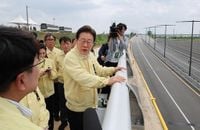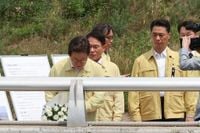President Lee Jae-myung visited the site of the tragic Osong Gongpyeong 2 Underground Road flood disaster on July 14, 2025, just one day before the second anniversary of the calamity that claimed 14 lives and injured 16 others. The disaster, which occurred on July 15, 2023, was caused by the overflow of the nearby Miho River following intense rainfall, leading to the collapse of an embankment and the subsequent submersion of the underground road in Osong-eup, Cheongju-si, Chungbuk Province.
During his visit, President Lee received detailed briefings from officials representing the Ministry of Environment and Chungcheongbuk-do Province. These briefings covered the causes of the embankment failure, the sequence of events leading to the flooding of the underground road, and the various improvement measures that have since been implemented. The President then conducted a thorough inspection of the disaster site and the underground road itself, paying close attention to the newly installed safety features such as vehicle entry barriers, emergency evacuation facilities, drainage pumps, handrails, and flood walls.
President Lee’s approach during the visit was notably systemic and forward-looking. He inquired whether the problems could be addressed solely by manpower or if structural and systemic reforms were necessary. Emphasizing the importance of clear accountability, he stated, “Local and central governments must clearly distinguish their respective responsibilities and take ownership of their roles.” He pressed further by questioning Chungbuk Governor Kim Young-hwan about the province’s flood-prone areas, the reasons behind insufficient water storage capacity, and the effectiveness of management for both local and national rivers.
Highlighting the importance of operational readiness, President Lee stressed that “improving disaster prevention facilities and providing financial support are as crucial as ensuring these facilities function properly through regular operational checks.” His attention to detail underscored a commitment not just to physical infrastructure but also to the processes that keep such infrastructure effective in times of crisis.
In a firm stance on accountability, President Lee reiterated that human casualties resulting from management negligence must be met with strict punishment. “If an accident occurs due to management negligence, accountability will be completely different from before,” he warned. “We must ensure that people do not die because what should have been done was not done.” This message reflects the President’s consistent position since taking office, where he has declared that “there is no such thing as ‘over-response’ when it comes to protecting the lives of citizens.”
The President and accompanying officials, including Kim Kwang-yong, Head of the Disaster Safety Management Headquarters of the Ministry of Interior and Safety, Kim Han-seung, Vice Minister of Environment, and Democratic Party Representative Lee Yeon-hee, wore black mourning ribbons to honor the victims during the visit. The somber occasion served as a reminder of the lives lost and the urgent need for effective disaster prevention and response mechanisms.
President Lee’s visit to Osong marked his first trip to Chungbuk Province since assuming office, signaling the priority his administration places on disaster safety and public welfare. Earlier that day, he delivered a special lecture to over 300 fifth-grade preliminary public officials at the National Human Resources Development Institute in Jincheon, Chungbuk. This was the first presidential special lecture to this group in 20 years, the last being delivered by former President Roh Moo-hyun in 2005. During his address, President Lee emphasized the ethical responsibilities of public officials, stating, “Public officials play a role akin to God. People's lives depend on your hands.” He urged officials to exercise vigilance, especially regarding financial relationships, warning that “money is the devil, but it never appears with a devil’s face; instead, it comes as the most beautiful angel, friend, relative, or lover.”
He further highlighted the necessity for decisive leadership, noting that “the people have entrusted you with the power to make tough decisions,” and reminded them that public service is not about pleasing everyone but about upholding truth and responsibility.
The visit and the President’s strong messages have already begun to influence political momentum. The national assembly’s investigation into the Osong disaster, which had stagnated amid political disputes, is expected to gain renewed urgency. Park Chan-dae, a candidate for the Democratic Party’s interim leadership, visited the disaster site later on July 14 and pledged to conduct a thorough national investigation and ensure accountability to prevent similar tragedies. He expressed deep sympathy for the bereaved families, saying, “It is unbearable to think of the bereaved families given that two years have passed without a clear investigation.” Another Democratic Party leadership candidate, Jeong Cheong-rae, had visited the families the previous week and also promised a national investigation.
Looking ahead, President Lee is scheduled to meet with bereaved families of various social disasters, including the Sewol Ferry sinking, the Itaewon crowd crush, the Mu’an passenger plane accident, and the Osong flood disaster, on July 16, 2025. This meeting underscores his administration’s commitment to addressing the pain of victims’ families and preventing future tragedies through systemic reform and accountability.
President Lee’s visit to the Osong disaster site and his emphatic calls for structural solutions, clear governmental responsibility, and strict punishment for negligence signal a more proactive and empathetic approach to disaster management in South Korea. His administration appears determined to break from past patterns, aiming to restore public trust and safeguard lives with unwavering resolve.


